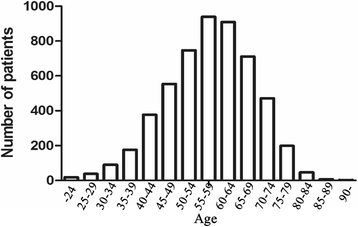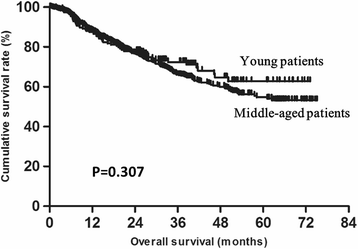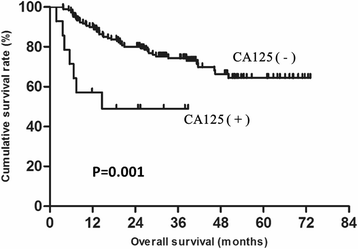Clinicopathological features and prognosis of gastric cancer in young patients
- PMID: 27418046
- PMCID: PMC4946107
- DOI: 10.1186/s12885-016-2489-5
Clinicopathological features and prognosis of gastric cancer in young patients
Abstract
Background: The clinicopathological features and prognosis of gastric cancer in young patients are both limited and controversial. Therefore, the aim of this study was to define the clinicopathological features and prognosis of gastric cancer in young patients after curative resection.
Methods: From May 2008 to December 2014, 198 young patients (age ≤ 40 years) and 1096 middle-aged patients (55 ≤ age ≤ 64 years) were enrolled in this study. The clinicopathological features and prognosis of gastric cancer in these patients were analyzed.
Results: Compared with middle-aged patients, the proportion of females, lower third tumors, tumor size less than 5 cm, poorly differentiated tumors and T1 tumors were significantly higher in young patients (all P < 0.05). The proportions of comorbidity, upper third tumors, well and moderately differentiated tumors, T4 tumors, and positive carcinoembryonic antigen (CEA), alpha fetoprotein (AFP) and carbohydrate antigen (CA) 19-9 were significantly lower in young patients (all P < 0.05). The distributions of N status and CA125 were comparable between young and middle-aged patients (all P > 0.05). The five-year overall survival rates were comparable between young patients and middle-aged patients (62.8 vs 54.7 %, P = 0.307). The tumor location, T status, N status and CA125 were independent predictors of prognosis in young patients. The overall survival of patients with tumors located in the upper or middle third was significantly lower than for those located in the lower third (60.8 vs 50.6 % vs 68.4 %, P = 0.016). The overall survival of CA125-positive patients was significantly lower than CA125-negative patients (49.0 vs 64.4 %, P = 0.001).
Conclusion: The clinicopathological features were significantly different between young and middle-aged patients. The prognosis of gastric cancer in young patients was equivalent to that of middle-aged patients. Tumor location, T status, N status and CA125 were independent risk factors for prognosis in young patients.
Keywords: Age; Gastric cancer, Young, Clinicopathological features, Prognosis.
Figures
References
-
- Chen W, Zheng R, Baade PD, Zhang S, Zeng H, Bray F, et al. Cancer statistics in China, 2015. CA: A Cancer Journal for Clinicians. 2016;66(2):115–32. - PubMed
-
- Kuller LH. Age-adjusted death rates: a hazard to epidemiology? Ann Epidemiol. 1999;9(2):91–2. - PubMed
-
- Takatsu Y, Hiki N, Nunobe S, Ohashi M, Honda M, Yamaguchi T, et al. Clinicopathological features of gastric cancer in young patients. Gastric Cancer. 2015;19(2):472–8. - PubMed
Publication types
MeSH terms
LinkOut - more resources
Full Text Sources
Other Literature Sources
Medical
Research Materials
Miscellaneous





